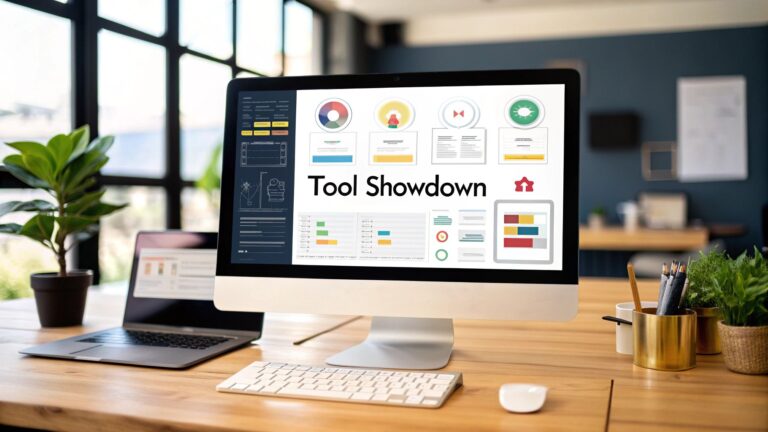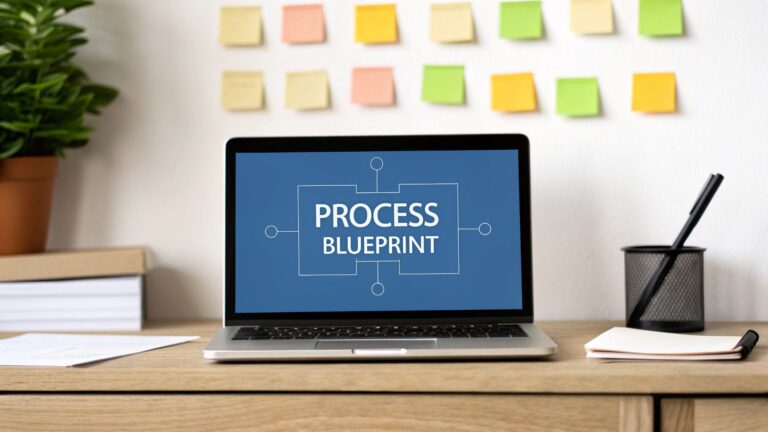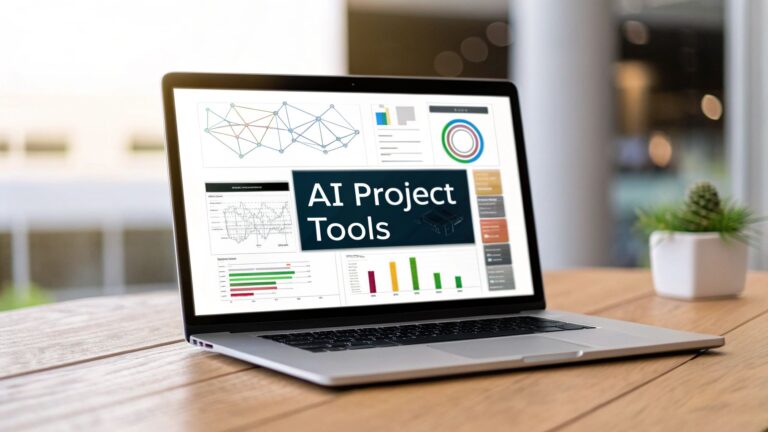How to Measure Employee Productivity Without the Metrics Trap
Measuring employee productivity isn't about tracking hours anymore.Measuring employee productivity isn't about tracking hours anymore. The real goal is to understand the impact and quality of the work being done. The best way to do this is by setting clear, role-specific goals, using the right tools to gather objective data, and then analyzing that information to empower your team—not to micromanage them. It's all about contribution, not just activity.
Moving Beyond Time Clocks and Task Counts
The old playbook for measuring productivity is completely broken. For decades, managers relied on things they could easily count: hours logged, tasks checked off a list, or units produced on an assembly line. That factory-floor mindset made sense when the output was physical, but it falls apart in today's knowledge-based economy where real value comes from innovation, creative problem-solving, and collaboration.
Simply put, busywork isn't the same as business impact. When you measure productivity by counting keystrokes or watching someone's online status, you're just encouraging people to look busy instead of actually being effective. This almost always backfires, leading straight to burnout, disengagement, and a culture where gaming the system is more important than delivering quality results.
The Problem with Outdated Metrics
These old-school methods are even more useless in modern remote and hybrid work environments. The true drivers of success—quality, creativity, and strategic thinking—can't be measured with a stopwatch.
Think about it this way:
- Activity vs. Accomplishment: An engineer who writes 500 lines of code might seem more productive than one who writes 50. But what if those 50 lines solve a critical bug that prevents a major system outage?
- Encouraging Burnout: Rewarding long hours over smart work sends a terrible message. It pressures employees to stay logged in long after their productive work is done, completely destroying any sense of work-life balance.
- Stifling Innovation: When people are judged on sheer volume, they have zero incentive to spend time on deep thinking, experimenting, or finding better ways to do things.
Reframing the Productivity Question
To really get a handle on productivity, you have to change the question you're asking. Stop asking, "Are my people busy?" and start asking, "Are my people making a meaningful impact?"
This shift in perspective requires a more thoughtful, human-centric approach. A huge part of this is setting clear expectations, which becomes much easier when you've documented your repeatable tasks. You can learn more about how to create SOPs to build these foundational standards for your team.
This bigger picture is crucial not just for your company, but for the economy as a whole. Labor productivity—often calculated as GDP divided by hours worked—is a major indicator of economic health. In 2023, the average labor productivity across OECD countries was around USD 70 per hour, which shows how efficiency directly connects to national output. You can find more of these cross-country productivity comparisons on OECD.org. By focusing on impactful work, you're helping build a more effective system for everyone.
Key Takeaway: Measuring productivity isn't about surveillance or counting things. It's about building a system that clarifies goals, removes roadblocks, and helps your team deliver high-value work that actually moves the business forward.
Defining What Productivity Actually Means for Your Team
Before you can even think about measuring productivity, you have to get crystal clear on what it actually looks like. I've seen too many companies try to apply a blanket definition across the board, and it just doesn't work. What makes a software engineer productive is worlds away from what makes a salesperson successful. The real goal here is to ditch the generic stuff and create definitions that reflect tangible value for each specific role.
This isn't something that should happen behind closed doors in a management meeting. The best, most effective way to nail this down is to bring your team into the conversation. When people have a hand in shaping their own metrics, they get it. They understand what success looks like and feel a sense of ownership over the results. It’s a powerful way to build trust and ensure the metrics are actually relevant to their day-to-day work.
Balancing The “What” And The “How”
A solid productivity framework needs to look at two sides of the same coin: the quantitative output (the 'what') and the qualitative approach (the 'how'). If you only focus on one, you’re missing half the story.
Think about it this way: a marketer who blasts out 10,000 emails might look great on paper. But if those campaigns result in zero leads? The effort was motion, not progress.
Here’s how this balance plays out in the real world:
- For a Software Developer, you wouldn't just count lines of code. You’d look at bug-free releases (the quantitative part) and then pair that with code maintainability and peer review feedback (the qualitative side).
- For a Customer Support Agent, you’d move beyond just the number of tickets closed. The real magic is in the Customer Satisfaction Score (CSAT) and first-contact resolution rate.
This is where a good dashboard comes in handy. It lets you see all these different data points in one place, connecting the dots between the numbers and the quality of the work.
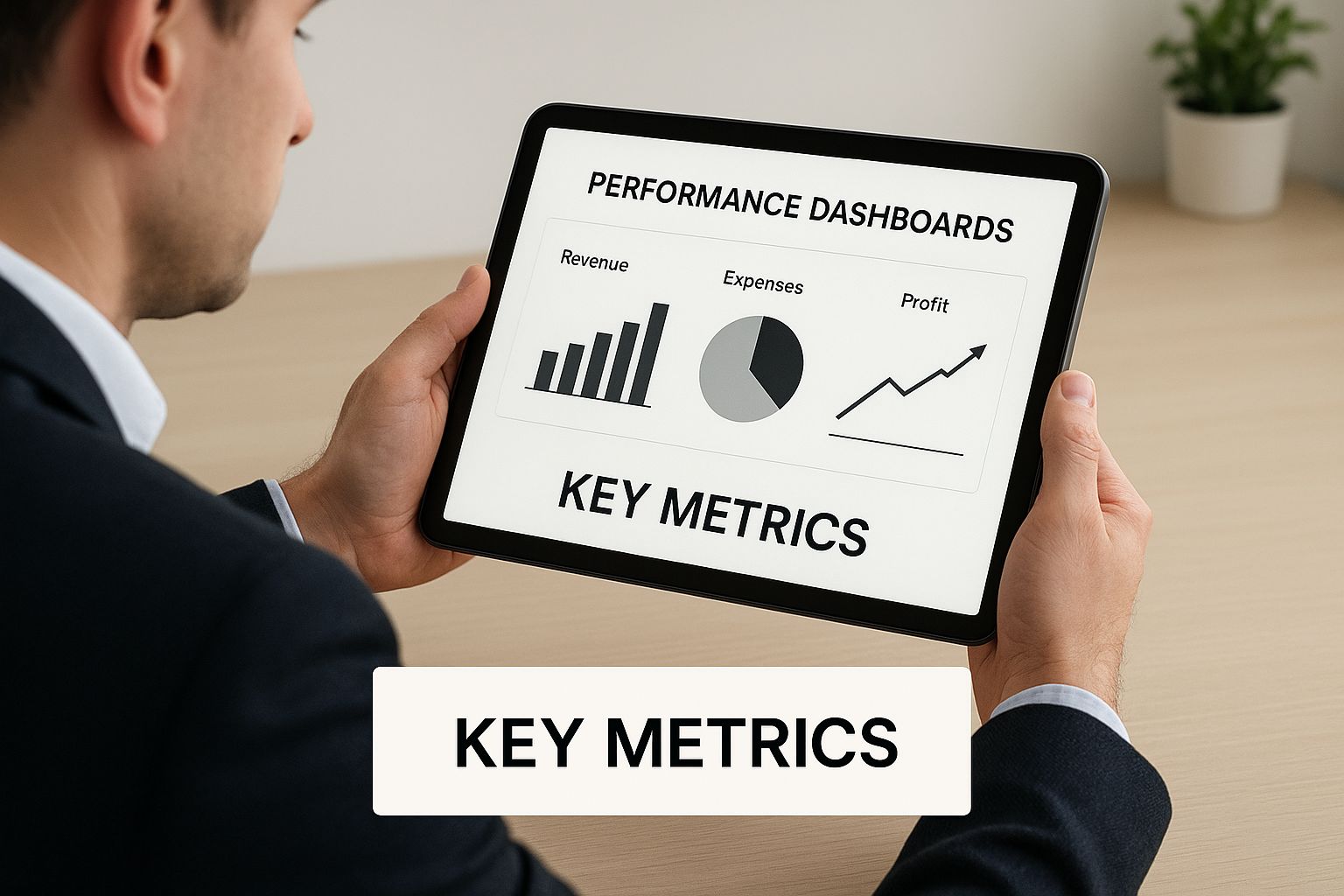
When you can visualize the data like this, it’s much easier for everyone to see the full picture and understand how different KPIs influence each other.
To further illustrate this, here’s a look at how you might structure these balanced metrics for a few different roles.
Sample Productivity Metrics By Role
| Role | Quantitative Metrics (The 'What') | Qualitative Metrics (The 'How') | Business Goal Alignment |
|---|---|---|---|
| Sales Development Rep | Number of qualified meetings booked | Quality of prospect notes in CRM | Increase sales pipeline velocity |
| Content Writer | Number of articles published | Organic search ranking for target keywords | Drive inbound lead generation |
| Product Manager | Feature adoption rate post-launch | Quality of stakeholder communication | Improve user retention and satisfaction |
This balanced approach ensures you're rewarding not just activity, but effective, high-quality work that truly moves the needle.
From Job Duties To Business Impact
Ultimately, the whole point of defining productivity is to draw a straight line from daily tasks to the company’s biggest goals. Every single metric should have a clear "why" behind it. This alignment gets everyone pulling in the same direction because they can see exactly how their work contributes to the company's success.
A great productivity metric doesn't just measure activity; it measures progress toward a meaningful goal. If a metric doesn't help you make better decisions or drive business outcomes, it's just noise.
For example, a content writer’s productivity isn't just about how many articles they write. A far more impactful metric would be the organic traffic generated from their articles or the number of marketing-qualified leads (MQLs) their content brings in. This ties their work directly to revenue.
Making these connections is fundamental to building a high-performing team and lines up with many proven performance management best practices. When you take the time to define productivity this thoughtfully, you create clarity, foster real ownership, and build a system that measures what truly matters.
Choosing Productivity Tools That Empower, Not Surveil
When you’re trying to figure out how to measure productivity, picking the right tech is a huge piece of the puzzle. It's also where a lot of leaders go wrong. The market is flooded with tools, and it's tempting to grab something that tracks everything. But the goal isn't to monitor; it's to empower.
Think of your tech stack as a support system, not a surveillance camera. The best tools shine a light on workflow bottlenecks and show you where things can be improved. They should never feel like a digital watchdog that just breeds mistrust. When your team sees a tool as something that helps them win—by killing repetitive tasks or clarifying who’s doing what—they’ll actually want to use it.
Differentiating Insight From Oversight
There's a fine line between helpful analytics and creepy, invasive tracking. The difference really comes down to your intent and how open you are about it. Are you gathering data to catch someone slacking off, or are you trying to find the systemic issues that are slowing everyone down?
True empowerment comes from using technology to answer bigger, more strategic questions. To get there, you should focus on tools that fall into these kinds of supportive categories:
- Project Management Platforms: Tools like Asana, Trello, or Jira give everyone a clear view of task progress, deadlines, and who has too much on their plate. They help you spot where projects are getting stuck without tracking every click and keystroke.
- Communication Analytics: Some platforms can analyze communication patterns—without reading private messages—to show you if teams are working in silos or if certain people are becoming information bottlenecks.
- Time and Task Automation: Any tech that helps manage schedules or automates mind-numbing tasks frees people up to do the high-impact work you hired them for. Digging into articles on specific productivity and scheduling tools can give you some great ideas for how to put this into practice.
The point isn't to track every minute of an employee's day. It's about understanding how work actually gets done and finding the friction that holds the whole team back.
Take a look at this comparison of different project management tools. It's a great high-level overview that shows just how diverse the options are.
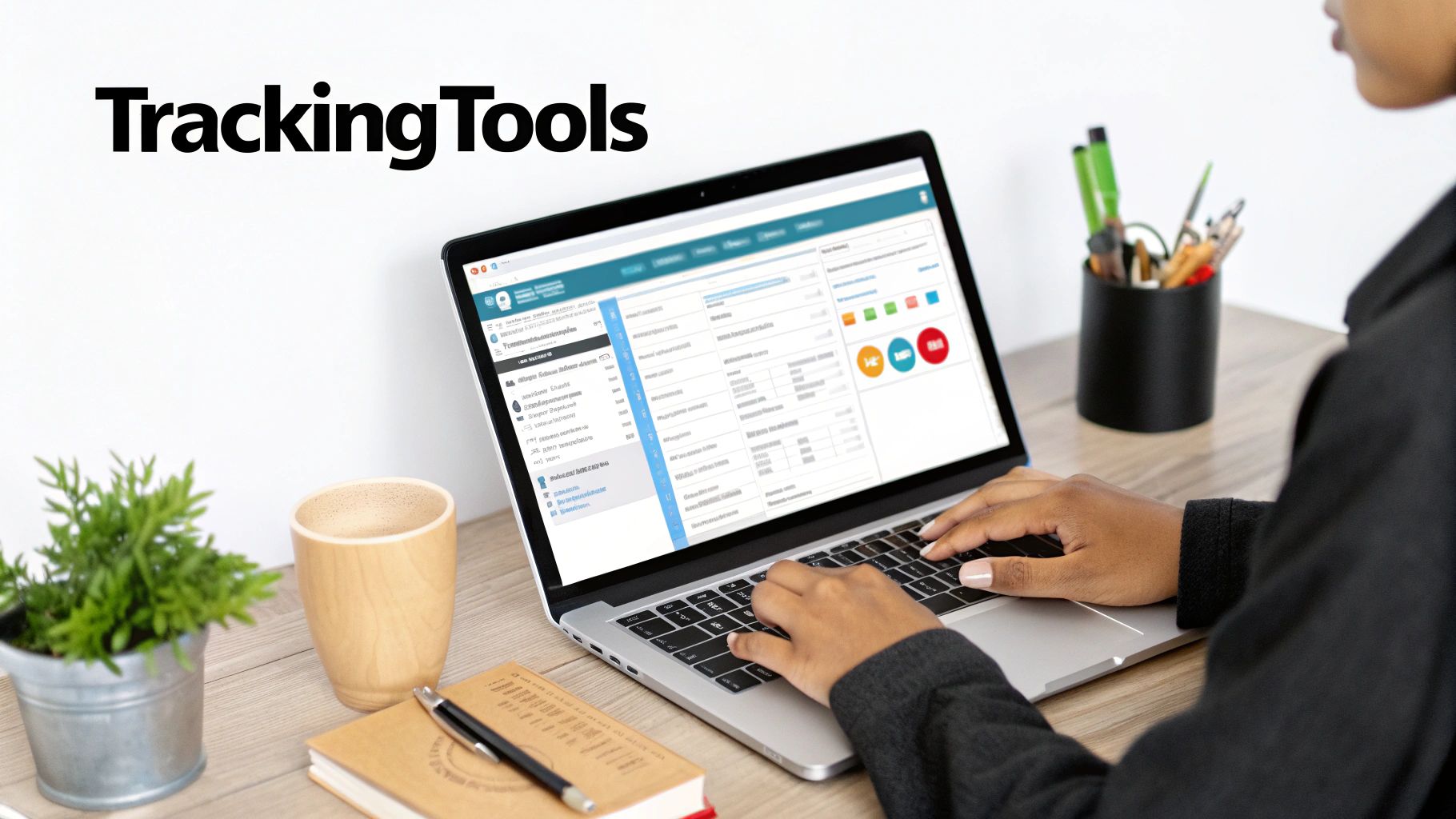
As you can see, there’s no single "best" tool. The right choice depends entirely on what your team actually needs, whether that's bug tracking, agile sprints, or simple task boards.
A Practical Checklist for Tool Selection
Before you sign on the dotted line for any new software, run it through this simple checklist. It’ll help you make sure you’re choosing empowerment over oversight.
- Does it solve a real problem for us? A tool should fix a specific pain point, like messy project handoffs or chaotic communication, not just add another login to everyone's list.
- Is it easy to use? If the software is clunky or has a steep learning curve, it'll just create more frustration. A clean, intuitive interface is an absolute must.
- Does it play nicely with our other tools? The last thing you want is another data silo. Make sure any new tool can integrate with the software your team already relies on every day.
- What data is it collecting and why? Be completely transparent about what’s being measured and how you plan to use that information to help the team. Transparency is everything.
- Is the focus on team or individual metrics? Stick to tools that give you insights into team-level workflows and collaboration. Avoid anything that feels like it’s just creating a log of individual activity.
When you carefully choose technology that truly serves your team, you build a foundation of trust. From there, you can gather meaningful data that leads to real, lasting improvements.
Turning Productivity Data Into Actionable Insights
https://www.youtube.com/embed/k51MH_Qc7ho
Collecting data is one thing, but it’s what you do with it that really counts. Raw numbers on a spreadsheet don’t tell you much. They’re just noise. The real magic happens when you can turn that noise into a clear story about what’s happening on your team and then use that story to make meaningful improvements.
This is where you answer the "so what?" question. You have all this information—what does it actually mean for your business? This is where a well-designed dashboard becomes your best friend, letting you see trends at a glance instead of getting lost in endless rows of data. If you need some inspiration, checking out these business intelligence dashboard examples can show you just how powerful visual data can be.
Identifying Performance Trends and Patterns
The first step is to zoom out. Don't get hung up on a single bad day or one missed deadline. You're looking for the bigger picture, so analyze the data over several weeks or even a few months to see what patterns emerge.
You should start asking some key questions:
- When are we at our best? Maybe your team is on fire mid-week but loses steam on Fridays. That’s a great insight to have when you're scheduling important meetings or deadlines.
- Where are things getting stuck? If one particular stage of every project seems to drag on forever, that's a sign to look at the process itself, not just the people doing the work.
- Who is knocking it out of the park? Figure out what your top performers are doing differently. Is it a specific workflow they've developed? The tools they use? Their knack for collaboration? Their habits are often a goldmine of best practices you can share.
Spotting these trends lets you shift from just putting out fires to making proactive changes that prevent them in the first place.
A word of caution: don’t confuse correlation with causation. Just because sales dip every time it rains doesn't mean the weather is tanking your business. You always have to dig deeper to find the real "why" behind what the data is showing you.
From Insights to Targeted Coaching
Once you have a handle on the patterns, you can start having much more productive, data-informed conversations with your team. This isn't about micromanaging or calling people out. It's about offering specific, targeted support where it's needed most.
Let's say you see a team member's task completion rate has dipped over the last month. Instead of a vague "How are things going?" you can open the conversation with concrete observations. Maybe they're juggling too many projects, or perhaps they could use a little extra training on a new software tool. Without the data, you’re just guessing. With it, you can pinpoint the actual problem and offer a solution that helps.
This data-driven approach is also crucial for employee development. We know from research that it can take a new hire anywhere from 8 to 12 months to get up to the same productivity level as a seasoned team member. When you understand that, you can build much better onboarding programs and set realistic expectations. If you're interested in the broader economic picture, the U.S. Bureau of Labor Statistics regularly posts updates on national labor productivity trends.
Refining Processes and Adjusting Workloads
Ultimately, the whole point of measuring productivity is to create a better, more efficient work environment for everyone. Your findings should lead directly to systemic improvements that make life easier for your team.
- Fix broken workflows: If the data screams that a certain process is clunky and slow, it's time to redesign it with your team's input.
- Balance the work: Use your insights to make sure work is distributed fairly. This prevents your top performers from burning out while also giving you a chance to support team members who might be struggling.
- Celebrate the wins: When you spot a positive trend or a big improvement, share it! Recognizing progress and success is one of the most powerful motivators you have.
When you consistently translate data into action, productivity measurement stops being about policing people and starts being a tool for empowerment.
Connecting Productivity with Employee Engagement

Trying to measure productivity without looking at employee engagement is a fool's errand. It’s like staring at the dashboard of a car that's run out of gas. You can track all the metrics in the world, but if your team isn't motivated, you're just measuring how slowly you're grinding to a halt.
The truth is, an engaged team is almost always a productive one. The connection is direct, powerful, and backed by some pretty stark numbers.
Globally, only 21% of employees actually feel engaged at work. That lack of connection isn't just a morale problem; it's a massive financial drain. In the U.S. alone, actively disengaged employees cost the economy somewhere between $483 to $605 billion every single year. These figures, highlighted in a report on the real cost of disengagement at Firstup.io, make it crystal clear why building a connected workforce isn't just a "nice-to-have." It's essential.
Building a Culture That Fuels Productivity
You can't just mandate engagement with a new policy or hope a single team-building day will fix everything. Real engagement sprouts from a culture that genuinely supports its people. This means creating an environment where employees feel valued, heard, and safe enough to bring their best ideas to the table without fear.
It all comes down to consistent, meaningful actions.
- Champion Transparent Communication: Keep everyone in the loop on company goals, wins, and even the challenges. When people understand the "why," their work suddenly has a purpose.
- Recognize Contributions: Make a habit of celebrating wins, both big and small. It's a simple act that reinforces great work and shows your team that you see and appreciate their efforts.
- Foster Psychological Safety: Build a space where it's okay to ask questions, admit mistakes, or challenge the status quo. This kind of trust is the bedrock of innovation and true collaboration.
Using Feedback to Create a Positive Loop
The data you get from productivity tools shouldn't live in a silo. It should directly inform your engagement efforts. Regular one-on-one meetings are the perfect forum to talk about performance data and personal well-being.
Don't just review the numbers. Use these conversations to dig deeper with powerful questions.
What’s getting in your way? What resources do you need to do your best work? Where do you feel most energized, and where are you feeling drained?
This approach creates a powerful, positive feedback loop. When you use productivity data to spot and remove roadblocks, you're proving to your team that you're invested in their success. That support naturally boosts engagement, which in turn leads to higher productivity.
It’s a cycle that feeds itself: supported, connected employees deliver exceptional work because they want to.
Got Questions? Let's Talk Productivity Measurement
Even with the best plan, rolling out a new way to measure productivity is going to stir up some questions. That's completely normal. You're dealing with people's work and their sense of value, so it's smart to anticipate their concerns and tackle them with open, honest answers.
The whole point is to build a more supportive, effective environment, not a place where everyone feels like they’re under a microscope.
What’s the Worst That Can Happen if We Measure Productivity Badly?
Getting this wrong can do more damage than not measuring anything at all. The absolute biggest pitfall is accidentally creating a culture of mistrust. If your team thinks you’re just tracking clicks and keystrokes, they'll feel spied on, not supported. That's a surefire recipe for anxiety, burnout, and a revolving door of talent.
You also run the risk of incentivizing the wrong behavior. When people are judged on simple, easy-to-game metrics, they'll focus on looking busy instead of actually being effective. This is a classic case of what's known as Goodhart's Law: when a measure becomes a target, it ceases to be a good measure. You end up killing the very creativity and collaboration you need to succeed.
How on Earth Do You Measure Productivity for a Writer or a Designer?
This is the million-dollar question for anyone managing creative or knowledge-based teams. The answer is to stop thinking about "activity" and start focusing on "impact." You can't just count widgets when the "widget" is a brilliant marketing campaign or a piece of clean, elegant code.
The trick is to blend objective project data with subjective, qualitative feedback.
For a role like a UX designer, for instance, you could look at a mix of things:
- Project velocity: Are they consistently moving projects from discovery to handoff on schedule? (Quantitative)
- Stakeholder feedback: What are product managers and engineers saying about the clarity and quality of their designs? (Qualitative)
- Business results: Did the new user flow they designed actually reduce cart abandonment or improve conversion rates? (Impact)
The key is to sit down with them and agree on what valuable work looks like in their role. It’s a conversation, not a decree.
How Do I Tell My Team We’re Going to Start Measuring This Stuff?
With total, unwavering transparency. This is not something you spring on people.
Start by explaining the why. Frame it as a tool to help everyone, not to police them. The goal is to spot roadblocks, fix broken processes, and find ways to help them do their best work with less friction. It’s about improvement, not punishment.
My best piece of advice: Get your team involved in choosing the metrics for their own roles. When they help build the system, they see it as fair and constructive. It becomes something you're doing with them, not to them.
Be explicit about what data you're gathering and how it will be interpreted. And finally, make it clear that this is a work in progress. Promise to revisit the metrics regularly and listen to their feedback. This turns it into a collaborative effort and shows you’re all on the same team.
Ready to stop guessing and start building efficient, scalable systems for your business? The team at MakeAutomation specializes in creating automated workflows that eliminate manual tasks and empower your team to focus on high-impact work. Explore our automation solutions and book a consultation today.

